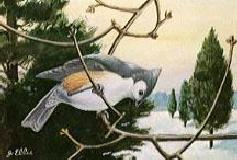

Chickadees |
& |
Titmice |

P. carolinensis |

P. bicolor |
|
| * click on above pictures or text to see related site. | ||
| .. | ||
| Higher Taxon: Family Paridae
Description
|
||
| Scientific Names | Common Names |
| P. atricapillus | Black-capped; Long Tail Chickadee |
| P. atricristatus | Grey-crested Chickadee |
| P. bicolor | Tuffted; Crested; Pete Bird Titmouse |
| P. carolinensis | Carolina; Florida Chickadee |
| P. cinctus | Siberian Tit |
| P. gambeli | Mountain; Bailey's Chickadee |
| P. hudsonicus | Boreal; Acadian; Brown-capped Chickadee |
| P. inornatus | Oak; Plain Titmouse |
| P. ridegwayi | Juniper Titmouse |
| P. rufescens | Chesnut-backed; Barlow's Chickadee |
| P. sclateri | Mexican; Sclater's Chickadee |
| P. wollweberi | Bridled Titmouse |
| (Audobon Encyclopedia of North American Birds, 1982) | ||||||||
|
Identification Guide
General Information Birds of the genus Parus are small hardy birds which show little fear of humans. They are slow in flight, averaging only 11 miles per hour. They like to nest in holes. Both males and females clear stumps for nests, but only females build the nests and incubate the eggs. These birds are active and acrobatic. They preen frequently and produce an oil from the uropygial gland, which is located near the base of the tail. The oil covers each feather and serves as an insulator and also increases their flexibility. Their appearance changes little through their life. They have no distinguishable immature plummage. When they are young they undergo a partial molt around mid-summer and after that they molt once a year. Both parents share in parental duties. Generally, they only have one brood per year. Once the young leave the nest they form flocks with older birds (Smith 1991). Within these flocks there exists a hierarchy or pecking order. A birds rank within the flock affects both its behavior and survival. They roam in these small bands except during the breeding season when they form monogamous pair bonds ( http://www.seepub.com/chickade.html) |
 Email Addie
Email Addie